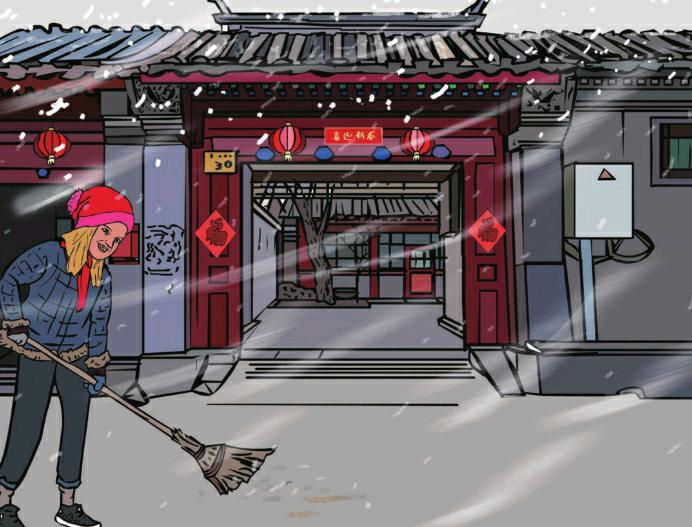The Hutong House in Winter
2017-12-28ByTamaraTreichel
By+Tamara+Treichel
I once overheard a German tourist pass- ing through my hutong (an alley in which single-storey residences are located side by side) neighborhood telling his travel companion that it was “romantic,” yet he wouldnt want to live here; and by way of comparison, the man mentioned the Fachwerkhaeuser, or half-timbered houses, in the German city of Tuebingen.
Having lived for several years in a groundfl oor apartment of a Baroque building in the historical district of the city of Heidelberg, Germany, I admit that living in “old” buildings, no matter where, is not for everyone. It takes a certain kind of person to weather and appreciate the experience. I consider myself fortunate to still be able to experience the “hutong culture,” as hutong houses are gradually disappearing. In fifty years, I suspect, there will be a lot fewer opportunities to live and breathe Beijing history in a hutong house.
Living in a hutong house is like waking up in a historical Bed and Breakfast 365 days a year. In my case, the head of my bed is only a stones throw from the Imperial Academy, where for centuries Chinas top scholars studied the classics. I have loved almost every second of my stay in my high-maintenance hutong house, even in the bitterly cold Beijing winters.
Spending the winter in a hutong house does have its challenges. For one, hutong houses are colder than average, as they are warmed by electric heaters rather than the government-subsidized heat you get in Beijings high rises. To illustrate this point, an American friend said that in a hutong house, you dont need to refrigerate your beer in the winter.
In my bathroom, there is a kind of basking light that supplies warmth, which makes me feel like a reptile in a terrarium when taking a shower in my “shoilet” (a shower located directly over the toilet, something many Westerners find hard to get used to). However, the water in my kitchen only runs cold, which might cause chilblains in the winter if one isnt careful, so I wash my dishes wearing rubber gloves.
In addition to the heaters, the southern exposure and thick walls of my hutong house also make for some warmth, as do the hot water bottles I tuck into my bed at night.
Besides the dual challenge of making and conserving heat as Beijing slipped from autumn into winter, I also had to counter the tidal wave of poplar leaves that broke over my little courtyard. These had to be removed regularly, as they posed a fi re hazard, so Thanksgiving found me sweeping up the leaves littering my courtyard.
Imagining I was a modern-day Thoreau who was living in the hutongs in order to confront only the essential facts of expat life, I stuffed the leaves into tiny garbage bags and put them into the communal trash bins in my hutong. I never thought I would come to China to “rake” leaves; this was an activity I associated with American lawns!
Ah, the Beijing winter! The neighborhood is a lot quieter. It is a church-like silence at times, with no chickens clucking or children playing. There are also fewer cat sightings in my hutong ‘hood. The house lizards are gone, and so are the chickens—all hibernating indoors or eaten.
Hutong houses stand out in their stark naked beauty in winter. This is the season to admire the designs on the roof tiles, for example, the jade rabbit from Chinese mythology that is supposed to be pounding the elixir of immortality, but looks as if it is actually mopping the fl oor. I discovered another tile depicting a rider bearing down on his horse as well as a series of tiles featuring a traditional Chinese knot. These I jokingly referred to as “China Unicom” tiles in reference to one of Chinas mobile service providers, which uses the very same design as its logo.
Winter is also the time to contemplate the inner beauty of hutong houses; the plaster fl aking off the moist walls and the dusty, sweetish-smelling museum-like articles that you may use during your tenancy. These objects are fossils; visit any one of Beijings former residences of famous people, hidden in the hutong, and you will see many such objects, only locked away behind glass.
Hutong life is a daily reminder of how enduring yet transient things are, and to me, thats what makes it absolutely beautiful, not to mention bearable.
